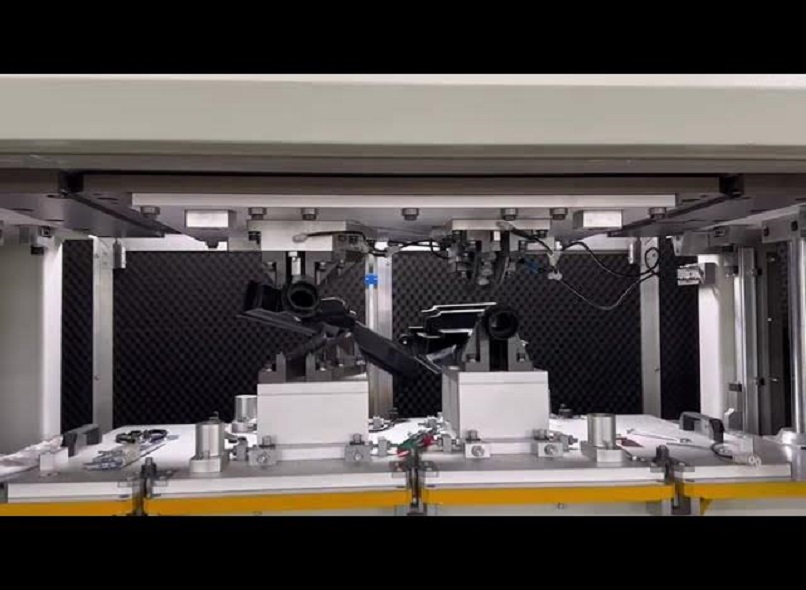Hot Plate Welding: Advantages and Disadvantages

Hot plate welding is a widely used technique in the field of plastic welding. It involves joining two plastic parts together by heating them with a hot plate and applying pressure to create a strong bond. While hot plate welding offers several advantages, it also has its share of disadvantages. In this article, we will explore the advantages and disadvantages of hot plate welding in more detail, discussing how recent advancements have addressed some of the limitations and expanded its applications. We will also delve into the key considerations for successful hot plate welding and provide insights into the future of this joining method.
Advantages of Hot Plate Welding
- Strong and Durable Joints: One of the key advantages of hot plate welding is its ability to create robust and long-lasting joints. The heat and pressure applied during the process result in a solid bond between the plastic parts, ensuring structural integrity. This is particularly important in applications where the welded parts will be subjected to various stresses and environmental conditions. Recent advancements in hot plate welding technology, such as improved temperature regulation and advanced heating elements, have further enhanced the strength and durability of the weld joints.
- Versatility: Hot plate welding can be used to join a wide range of plastic materials, including polyethylene, polypropylene, and polyvinyl chloride (PVC). This versatility makes it suitable for various industries and applications. Whether you need to join small or large plastic components, hot plate welding can accommodate different shapes, sizes, and thicknesses, offering flexibility in design and allowing for the creation of complex assemblies. Recent advancements in hot plate welding technology have expanded its capabilities, making it even more versatile and adaptable to different plastic materials and applications.
- Uniform Heating: The hot plate provides uniform heating, ensuring consistent melting and fusion of the plastic parts. This leads to reliable and consistent weld quality. The precise control of temperature and pressure during the process ensures consistent weld strength and integrity, resulting in high-quality joints. Recent advancements in hot plate welding technology, such as the integration of temperature sensors and feedback control systems, have further improved temperature regulation, ensuring optimal welding conditions and enhancing the quality and reliability of the weld joints.
- Large Part Size Capability: Hot plate welding is suitable for joining large plastic parts. The size of the hot plate can be customized according to the dimensions of the parts, allowing for the welding of components of various sizes. This makes hot plate welding an ideal choice for applications that involve large plastic assemblies, such as automotive components, industrial equipment, and medical devices. Recent advancements in hot plate welding technology, such as the use of advanced heating elements and improved insulation, have increased the efficiency and effectiveness of joining large parts, reducing cycle times and improving productivity.
- Cost-Effective: Hot plate welding is a cost-effective method compared to other plastic joining techniques. It requires relatively simple equipment and does not involve the use of additional consumables or adhesives. By utilizing heat and pressure, hot plate welding creates strong bonds without the need for additional materials, reducing costs and simplifying the welding process. This makes it an attractive option for manufacturers looking to optimize their production processes while keeping costs under control. Recent advancements in hot plate welding technology, such as improved heating element materials and automation and robotics integration, have further enhanced the cost-effectiveness of the process, reducing energy consumption and increasing production speed.
Disadvantages of Hot Plate Welding
- Cycle Time: Hot plate welding can have longer cycle times compared to other welding techniques. The heating and cooling processes take time, which can affect production efficiency. However, advancements in hot plate welding technology, such as improved temperature regulation and faster heating elements, have helped reduce cycle times and increase production speed. Furthermore, the integration of automation and robotics into hot plate welding systems has improved cycle times by enabling high-speed and consistent weld production.
- Surface Finish: The hot plate welding process can leave visible marks or blemishes on the surface of the welded parts. This may not be desirable for applications that require a smooth or aesthetically pleasing finish. However, with proper process control and post-weld finishing techniques, such as polishing or smoothing, the surface finish can be improved to meet the desired requirements. Recent advancements in hot plate welding technology, such as improved heating element materials and surface treatment options, have addressed surface finish concerns, allowing for better aesthetic results.
- Material Compatibility: While hot plate welding is versatile, not all plastic materials are suitable for this technique. Some materials may not melt or fuse properly, leading to weak joints or compatibility issues. It is important to carefully evaluate the compatibility of different materials before attempting hot plate welding. Conducting compatibility tests and consulting material compatibility charts can help manufacturers select the most suitable combinations for achieving strong and durable welds. Recent advancements in hot plate welding technology, such as improved heating element materials and process controls, have expanded the range of compatible materials, allowing for greater flexibility in material selection.
- Energy Consumption: Hot plate welding requires a significant amount of energy to heat the hot plate and maintain the desired temperature throughout the welding process. This can result in higher energy consumption compared to other joining methods. However, advancements in hot plate welding technology, such as the use of advanced heating elements and improved insulation, have helped reduce energy consumption and increase overall efficiency. Additionally, the integration of automation and robotics into hot plate welding systems has improved energy efficiency by optimizing process control and reducing human error.
- Limited Joint Configuration: Hot plate welding is more suitable for joining flat or planar parts. It may not be as effective for complex or three-dimensional joint configurations. The design of the parts being joined should take into consideration the limitations of hot plate welding. In some cases, alternative joining methods, such as ultrasonic welding or vibration welding, may be more suitable for achieving the desired joint configuration. However, recent advancements in hot plate welding technology, such as the development of specialized fixtures and tooling, have expanded the possibilities for joining complex and three-dimensional parts, allowing for greater flexibility in joint configuration.
Key Considerations for Successful Hot Plate Welding
To achieve successful hot plate welding, there are several key considerations that manufacturers should keep in mind:
- Material Selection: Carefully consider the thermal characteristics of the materials being joined and select combinations that exhibit compatible thermal properties. This ensures that the heat is evenly distributed, promoting optimal bonding and weld strength.
- Chemical Compatibility: In addition to melting points and thermal properties, the chemical composition of the materials is a critical factor in determining compatibility for hot plate welding. Different thermoplastic materials possess unique chemical compositions, which can impact their compatibility with the welding process. Some materials may contain additives, fillers, or modifiers that can affect the welding process or compromise the integrity of the weld. Therefore, it is essential to thoroughly evaluate the chemical compatibility of the materials to ensure successful bonding.
- Compatibility Testing: To assess the compatibility of materials for hot plate welding, it is recommended to conduct comprehensive compatibility tests. These tests involve joining small samples of the materials and evaluating the strength and quality of the resulting welds. Through these tests, manufacturers can ascertain whether the materials exhibit the desired compatibility for hot plate welding or if alternative joining methods should be considered. Compatibility testing provides valuable insights into the behavior of the materials during the welding process and helps in selecting the most suitable combinations for achieving strong and durable welds.
The Future of Hot Plate Welding
Hot plate welding continues to evolve and improve as new technologies and materials are introduced. The advancements in hot plate welding technology are focused on addressing the limitations and challenges associated with the technique, further expanding its applications and improving its efficiency. Some of the areas of development include:
- Process Automation: The integration of automation and robotics into hot plate welding systems is expected to increase efficiency, reduce cycle times, and improve weld quality. Automated systems can precisely control the temperature, pressure, and welding parameters, ensuring consistent and reliable welds. This also reduces the dependence on operator skill and minimizes human error.
- Advanced Heating Elements: The development of advanced heating elements, such as infrared or induction heating, can enhance the efficiency and effectiveness of hot plate welding. These heating technologies offer faster heating and cooling rates, reducing cycle times and increasing production speed. They also provide more precise temperature control, resulting in improved weld quality and consistency.
- Material Innovations: The introduction of new thermoplastic materials with improved compatibility and performance characteristics opens up new possibilities for hot plate welding applications. Manufacturers are continuously exploring and developing materials that exhibit better melt flow, higher strength, enhanced chemical resistance, and improved heat resistance, among other properties. These advancements in material science enable hot plate welding to be applied to a wider range of industries and products.
- Energy Efficiency: The focus on sustainability and energy efficiency has led to the development of energy-efficient hot plate welding systems. Efforts are being made to reduce energy consumption through the use of efficient heating elements, insulation materials, and process optimization techniques. This not only reduces the environmental impact but also lowers operational costs for manufacturers.
In conclusion, hot plate welding offers several advantages, including strong joints, versatility, uniform heating, large part size capability, and cost-effectiveness. However, it also has its disadvantages, such as longer cycle times, surface finish concerns, material compatibility limitations, higher energy consumption, and limited joint configuration options. Understanding the advantages and disadvantages of hot plate welding, along with the recent advancements in technology, can help manufacturers make informed decisions and maximize the benefits of this joining method. With continuous innovation and improvement, hot plate welding continues to be a reliable and efficient technique for joining plastic components in various industries. As technology continues to advance, the field of hot plate welding is poised to deliver even more efficient and sustainable joining solutions for plastic and other thermoplastic materials.





